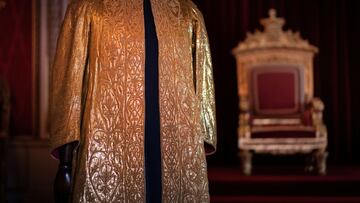Where is Westminster Abbey, the site of the Coronation of King Charles III
Westminster Abbey is located north of the River Thames. It is known for being the site of coronations, funerals and other royal events.

Westminster Abbey is an Anglican church located in the Westminster district of the City of London, north of the River Thames. The historical structure has been, and continues to be the site for royal coronations, funerals, and other acts of an institutional nature.
This Saturday, the world will watch the coronation of King Charles III of England live from Westminister Abbey.
The Gothic-style building was declared a UNESCO World Heritage Site, in 1987, along with St. Margaret’s Church and the Houses of Parliament.
- King Charles III Coronation: Follow live online updates and commentary here!
The end of the Roman Empire at the end of the 5th century AD gave way to barbarian invasions in what is now the British Isles. The former province of Britain was occupied by the Anglo-Saxons, and Christianity began to spread throughout Europe from Constantinople, the capital of the Eastern Roman Empire.
The Origins of Westminster Abbey
In 596, Pope Gregory the Great sent a Christian mission to the Anglo-Saxons. This mission was led by the Benedictine monk Augustine of Canterbury, the first Archbishop of Canterbury, considered the apostle of England and one of the fathers of the Latin Church. The influence of Christianity extended as far as the ancient Roman capital of the province, Londinium. A church dedicated to Saint Paul was erected there as a new episcopal seat in the walled Roman perimeter.
Legend places its origin in the foundation of a sanctuary on the island of Thorney at the beginning of the 7th century AD. The building was consecrated to Saint Peter after a vision of the apostle by a local fisherman. This site later became a Benedictine monastery. Centuries later, during the Viking invasion and conquest, Edward the Confessor seized the English throne after being banished to Normandy. During exile, he promised to make a pilgrimage to Rome if his family regained the throne in Britain. However, Pope Leo IX, due to the political instability of the time, asked him not to do so and, in exchange, to subsidize and expand the Thorney monastery. The King built an abbey adjacent to the religious center that would soon begin to be called “West Minster,” the church of the west, to differentiate it from its namesake in the east, that of Saint Paul’s erected in the city.
This is how Westminster Abbey came to be constructed in 1051, and explains its Romanesque style. However, Edward the Confessor was unable to attend its inauguration due to a serious illness from which he died days later. The late king was buried in the abbey and, years later, William the Conqueror was proclaimed king there as well. A tradition that, with few exceptions, has always been fulfilled at the abbey.
Only two monarchs in the country’s history have not been crowned here. Edward V (1483) was titled sovereign but not crowned because he was a minor. And he didn’t live for it since he was allegedly murdered by his uncle and heir to the throne, Richard III. The happiness of the new king would not last long since he would die two years later in the battle of Bosworth.
The second monarch not to be enthroned in Westminster Abbey is the controversial Edward VIII, uncle of the late Queen Elizabeth II. He attended his proclamation ceremony from one of the windows of St. James’s Palace, along with his mistress, the commoner Wallis Simpson. Popular pressure would make the monarch abdicate a year later in favor of his brother, George VI, in 1936, without having been crowned.
The current architecture of the building
The present building was constructed by King Henry III and inspired by the French architectural style and the newer cathedral buildings of Canterbury, Winchester, and Salisbury. The aim was to establish a religious hub that would also function as a grand venue for coronations and a royal tomb. Similar to St. Paul’s Cathedral in London (the “east”), the nave is designed in the shape of a cross, commemorating the crucifixion of Jesus. Additionally, there is a chapel dedicated to Saint Edward the Confessor.
Related stories
The construction of the abbey continued until the 14th century. During the reign of Henry VII, modifications were made, including a new chapel named the Lady Chapel, dedicated to the Virgin Mary in 1503. After being returned to the Benedictines by Catholic Queen Mary, the church was converted into a cathedral in 1540. However, Queen Elizabeth I made changes to Mary’s decision and reinstated the status of Collegiate Church of Saint Paul under the direct jurisdiction of the crown.
More than just an important spot for the Royal Family
After the execution of Charles I, Oliver Cromwell in 1649 established a republic called the Commonwealth. The leader was buried here, and from then on, the burial of famous personalities in the abbey became popular. To name a few: Isaac Newton, Robert Blake, Lord Byron, Charles Dicken, Henry James, David Livingston, Geoffrey Chaucer...